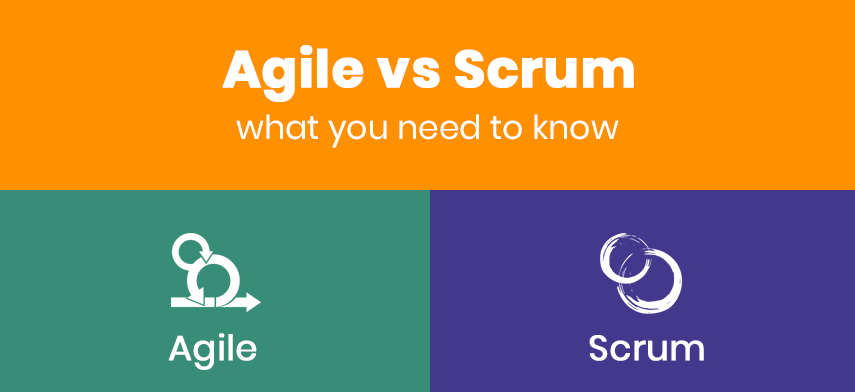
Excerpt: Agile is a project management methodology, and Scrum is one sort of Agile methodology. So here we will do a quick look into both of these and have a quick comparison.
Read Time: 5 mins 13 seconds
Application Modernisation
Agile project management emphasises completing tasks in tiny chunks. It’s frequently employed in initiatives when there’s a chance of change or unpredictability. Scrum, on the other hand, is an Agile methodology. Consider it more of a structure that teams may utilise to put Agile ideas into action.
Scrum is such a popular Agile methodology—nearly 80% of Agile adopters utilise Scrum or a Scrum hybrid method—that the terms Scrum and Agile are sometimes interchanged [1]. As a result, it’s understandable if you’re perplexed. Let’s look at what makes Scrum and Agile so special, as well as how and when you should use them.
Agile vs Scrum
The primary distinction between Scrum and Agile is that Agile is a project management style, whereas Scrum is one of the various methodologies for implementing that approach.
What is Agile?

Agile project management is a methodology or philosophy that focuses on achieving a goal in small steps. An Agile project, rather than having a single huge reveal or launch, is made up of smaller pieces of activities that may be delivered over time. This makes it easier for project teams to adjust to shifting priorities, respond to difficulties, and save money, time, and effort.
You’ll need to employ a framework or a process to implement Agile principles into a firm or project. Scrum is the most well-known. Kanban, the Crystal Method, Extreme Programming, and a variety of hybrids are some of the others.
The Agile project management methodology is based on four values:
- Individuals and interactions are more important than processes and instruments.
- Working software takes precedence over thorough documentation.
- Customer collaboration takes precedence over contract negotiations.
- Responding to change in a planned manner
In most cases, the bolded phrases take precedence over the unbolded.
Agile began as a software development methodology, but it is now utilised in a wide range of industries, including technology, marketing, design, and finance. Many industries that formerly relied on traditional project management approaches, such as construction, have begun to adopt Agile practices.
When should you use Agile?
Agile is a good fit for ongoing projects and projects where key details aren’t obvious right away. Agile is ideal for companies that deal with frequent or unforeseen changes, as well as teams developing new products. Traditional project management approaches, such as Waterfall, may be better suited to projects with stringent limits, such as a set deadline or budget, such as event planning.
What is Scrum?

Scrum is an Agile process for developing products in a fluid setting.
Delivery cycles in Scrum are referred to as “sprints,” and they typically run one to four weeks. Work is done in stages and builds on earlier efforts. Scrum teams are usually small, with a Scrum master and a product owner. Communication with team members and stakeholders is consistent, allowing for timely feedback and appropriate improvements.
By far the most popular Agile approach is Scrum. According to the State of Agile study released in 2020, 78% of Agile users employ Scrum or a hybrid Scrum approach. Scrumban and Scrum/XP are two popular hybrid Scrum approaches.
Scrum is based on three principles:
Transparency: All participants have complete access to all relevant information, including progress and objectives.
Adaptation: The project and activities may be modified to reflect new priorities.
Inspection: The team works hard to enhance the product and the process on a regular basis.
In addition, there are five values:
- Courage
- Focus
- Commitment
- Respect
- Openness
When should you use Scrum?
Scrum is ideal for managing complicated projects in dynamic contexts. Scrum, like many Agile techniques, is ideal for sectors that are continuously changing or for new project development. A more traditional method can be beneficial if you’re dealing with predefined needs or an organisation that doesn’t allow for seamless cross-functional communication.
Agile vs Scrum

Scrum is a strategy for implementing Agile, which is a project management approach. Scrum contains a few elements that are reflective of Agile concepts, as well as a few features that distinguish it from the rest of the philosophy.
Here are some of the important commonalities between Scrum and Agile that help to distinguish Scrum as an Agile methodology:
- Short-term development cycles
- Focus on people, collaboration, and communication
- Capacity to adapt to changes and feedback
Here’s what makes Scrum different from other Agile methodologies:
- Work is broken down into sprints of one to four weeks.
- A product backlog is a list of tasks that need to be completed.
- Scrum master, product owner, and development team are the different roles.
- A short “daily Scrum” update meeting is held for the team.
Do you really need to choose between Agile and Scrum?
You don’t have to, is the simple answer. Scrum is an umbrella philosophy, therefore if you choose it, you’ll certainly use Agile principles. Scrum is another commonly used methodology that can help you get started with Agile with your team. Various Agile approaches, such as Kanban and XP, can be used instead.
Scrum vs Kanban

The Japanese word “kanban” means “signboard.” The method employs a whiteboard (virtual or actual) separated into columns that represent various project phases. A sticky note or card that represents the project is transferred into the following step as the project proceeds until it is done. It’s a fantastic tool for visualising the process and identifying bottlenecks.
Unlike Scrum, Kanban does not place a premium on defined deadlines, and work is done in a continuous flow. Product owners’ roles aren’t decided right away. Scrumban is a hybrid approach that combines Scrum and Kanban concepts.
Agile vs Scrum
The primary distinction between Scrum and Agile is that Agile is a project management style, whereas Scrum is one of the various methodologies for implementing that approach.
What is Agile?
Agile project management is a methodology or philosophy that focuses on achieving a goal in small steps. An Agile project, rather than having a single huge reveal or launch, is made up of smaller pieces of activities that may be delivered over time. This makes it easier for project teams to adjust to shifting priorities, respond to difficulties, and save money, time, and effort.
You’ll need to employ a framework or a process to implement Agile principles into a firm or project. Scrum is the most well-known. Kanban, the Crystal Method, Extreme Programming, and a variety of hybrids are some of the others.
The Agile project management methodology is based on four values:
- Individuals and interactions are more important than processes and instruments.
- Working software takes precedence over thorough documentation.
- Customer collaboration takes precedence over contract negotiations.
- Responding to change in a planned manner
In most cases, the bolded phrases take precedence over the unbolded.
Agile began as a software development methodology, but it is now utilised in a wide range of industries, including technology, marketing, design, and finance. Many industries that formerly relied on traditional project management approaches, such as construction, have begun to adopt Agile practices.
When should you use Agile?
Agile is a good fit for ongoing projects and projects where key details aren’t obvious right away. Agile is ideal for companies that deal with frequent or unforeseen changes, as well as teams developing new products. Traditional project management approaches, such as Waterfall, may be better suited to projects with stringent limits, such as a set deadline or budget, such as event planning.
What is Scrum?
Scrum is an Agile process for developing products in a fluid setting.
Delivery cycles in Scrum are referred to as “sprints,” and they typically run one to four weeks. Work is done in stages and builds on earlier efforts. Scrum teams are usually small, with a Scrum master and a product owner. Communication with team members and stakeholders is consistent, allowing for timely feedback and appropriate improvements.
By far the most popular Agile approach is Scrum. According to the State of Agile study released in 2020, 78% of Agile users employ Scrum or a hybrid Scrum approach. Scrumban and Scrum/XP are two popular hybrid Scrum approaches.
Scrum is based on three principles:
Transparency: All participants have complete access to all relevant information, including progress and objectives.
Adaptation: The project and activities may be modified to reflect new priorities.
Inspection: The team works hard to enhance the product and the process on a regular basis.
In addition, there are five values:
- Courage
- Focus
- Commitment
- Respect
- Openness
When should you use Scrum?
Scrum is ideal for managing complicated projects in dynamic contexts. Scrum, like many Agile techniques, is ideal for sectors that are continuously changing or for new project development. A more traditional method can be beneficial if you’re dealing with predefined needs or an organisation that doesn’t allow for seamless cross-functional communication.
Agile vs Scrum
Scrum is a strategy for implementing Agile, which is a project management approach. Scrum contains a few elements that are reflective of Agile concepts, as well as a few features that distinguish it from the rest of the philosophy.
Here are some of the important commonalities between Scrum and Agile that help to distinguish Scrum as an Agile methodology:
- Short-term development cycles
- Focus on people, collaboration, and communication
- Capacity to adapt to changes and feedback
Here’s what makes Scrum different from other Agile methodologies:
- Work is broken down into sprints of one to four weeks.
- A product backlog is a list of tasks that need to be completed.
- Scrum master, product owner, and development team are the different roles.
- A short “daily Scrum” update meeting is held for the team.
Do you really need to choose between Agile and Scrum?
You don’t have to, is the simple answer. Scrum is an umbrella philosophy, therefore if you choose it, you’ll certainly use Agile principles. Scrum is another commonly used methodology that can help you get started with Agile with your team. Various Agile approaches, such as Kanban and XP, can be used instead.
Scrum vs Kanban
The Japanese word “kanban” means “signboard.” The method employs a whiteboard (virtual or actual) separated into columns that represent various project phases. A sticky note or card that represents the project is transferred into the following step as the project proceeds until it is done. It’s a fantastic tool for visualising the process and identifying bottlenecks.
Unlike Scrum, Kanban does not place a premium on defined deadlines, and work is done in a continuous flow. Product owners’ roles aren’t decided right away. Scrumban is a hybrid approach that combines Scrum and Kanban concepts.
Agile vs Scrum
The primary distinction between Scrum and Agile is that Agile is a project management style, whereas Scrum is one of the various methodologies for implementing that approach.
What is Agile?
Agile project management is a methodology or philosophy that focuses on achieving a goal in small steps. An Agile project, rather than having a single huge reveal or launch, is made up of smaller pieces of activities that may be delivered over time. This makes it easier for project teams to adjust to shifting priorities, respond to difficulties, and save money, time, and effort.
You’ll need to employ a framework or a process to implement Agile principles into a firm or project. Scrum is the most well-known. Kanban, the Crystal Method, Extreme Programming, and a variety of hybrids are some of the others.
The Agile project management methodology is based on four values:
- Individuals and interactions are more important than processes and instruments.
- Working software takes precedence over thorough documentation.
- Customer collaboration takes precedence over contract negotiations.
- Responding to change in a planned manner
In most cases, the bolded phrases take precedence over the unbolded.
Agile began as a software development methodology, but it is now utilised in a wide range of industries, including technology, marketing, design, and finance. Many industries that formerly relied on traditional project management approaches, such as construction, have begun to adopt Agile practices.
When should you use Agile?
Agile is a good fit for ongoing projects and projects where key details aren’t obvious right away. Agile is ideal for companies that deal with frequent or unforeseen changes, as well as teams developing new products. Traditional project management approaches, such as Waterfall, may be better suited to projects with stringent limits, such as a set deadline or budget, such as event planning.
What is Scrum?
Scrum is an Agile process for developing products in a fluid setting.
Delivery cycles in Scrum are referred to as “sprints,” and they typically run one to four weeks. Work is done in stages and builds on earlier efforts. Scrum teams are usually small, with a Scrum master and a product owner. Communication with team members and stakeholders is consistent, allowing for timely feedback and appropriate improvements.
By far the most popular Agile approach is Scrum. According to the State of Agile study released in 2020, 78% of Agile users employ Scrum or a hybrid Scrum approach. Scrumban and Scrum/XP are two popular hybrid Scrum approaches.
Scrum is based on three principles:
Transparency: All participants have complete access to all relevant information, including progress and objectives.
Adaptation: The project and activities may be modified to reflect new priorities.
Inspection: The team works hard to enhance the product and the process on a regular basis.
In addition, there are five values:
- Courage
- Focus
- Commitment
- Respect
- Openness
When should you use Scrum?
Scrum is ideal for managing complicated projects in dynamic contexts. Scrum, like many Agile techniques, is ideal for sectors that are continuously changing or for new project development. A more traditional method can be beneficial if you’re dealing with predefined needs or an organisation that doesn’t allow for seamless cross-functional communication.
Agile vs Scrum
Scrum is a strategy for implementing Agile, which is a project management approach. Scrum contains a few elements that are reflective of Agile concepts, as well as a few features that distinguish it from the rest of the philosophy.
Here are some of the important commonalities between Scrum and Agile that help to distinguish Scrum as an Agile methodology:
- Short-term development cycles
- Focus on people, collaboration, and communication
- Capacity to adapt to changes and feedback
Here’s what makes Scrum different from other Agile methodologies:
- Work is broken down into sprints of one to four weeks.
- A product backlog is a list of tasks that need to be completed.
- Scrum master, product owner, and development team are the different roles.
- A short “daily Scrum” update meeting is held for the team.
Do you really need to choose between Agile and Scrum?
You don’t have to, is the simple answer. Scrum is an umbrella philosophy, therefore if you choose it, you’ll certainly use Agile principles. Scrum is another commonly used methodology that can help you get started with Agile with your team. Various Agile approaches, such as Kanban and XP, can be used instead.
Scrum vs Kanban
The Japanese word “kanban” means “signboard.” The method employs a whiteboard (virtual or actual) separated into columns that represent various project phases. A sticky note or card that represents the project is transferred into the following step as the project proceeds until it is done. It’s a fantastic tool for visualising the process and identifying bottlenecks.
Unlike Scrum, Kanban does not place a premium on defined deadlines, and work is done in a continuous flow. Product owners’ roles aren’t decided right away. Scrumban is a hybrid approach that combines Scrum and Kanban concepts.
Scrum vs XP

Extreme Programming (XP) is a software development Agile approach. It emphasises small releases and iteration, as do other Agile approaches. Pair programming, in which two developers collaborate to create code, is a hallmark of XP.
Learning Agile and Scrum
Agile project management is a relatively new project management philosophy that first appeared in 2001 and has subsequently grown in popularity across a wide range of sectors. Agile and Scrum are likely to become standard practises for more businesses as project management continues to be in high demand.
Consider taking the Google Project Management: Professional Certificate if you’re interested in learning more. There’s a whole course dedicated to Agile and Scrum ideas, as well as other modules aimed to get you job-ready in six months or less.











